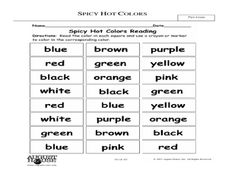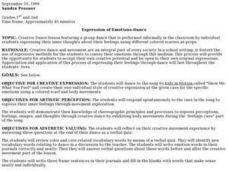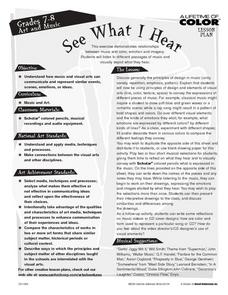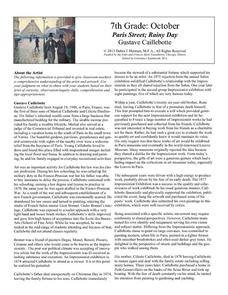Learning for Justice
Looking Closely at Ourselves
A thoughtful discussion about self-reflecting leads to a conversation about skin color and making a list of words associated with "beauty." Budding artists use a mirror to examine their features and create a self-portrait. Peers critique...
Anti-Defamation League
Emojis and Me
A lesson features the work of O'Plérou Grebet, a graphic designer who created a collection of emojis to represent his life in West Africa. Scholars explore the history and purpose of emojis, then read and discuss an article about...
Teaching Tolerance
Using Photographs to Teach Social Justice | Exposing Gender Bias
Young sociologists are asked to read two photographs, identifying how the photographer uses point of view, color, pose, light, and shadow to express a stereotype of women or to challenge those stereotypes. Partners then create their own...
Curated OER
Spicy, Hot Colors
Students demonstrate an understanding of colors. In this visual arts lesson plan, students read the text Hot, Spicy Colors and name their favorite colors. Students complete a bar graph to show the data. Students discuss how each color...
Curated OER
Writing a Memorable Poem
Nascent poets carefully examine a color photograph and then respond to a series of questions. Using these responses, they craft a poem prompted by the image. A link to powerful photos is included so the exercise can be repeated.
Curated OER
Vegetable Print Patterns
Create a unique print using vegetable stencils and tempera paints applied to grid like pattern formed from cut pieces of paper. Your students will choose either a warm or a cool color scheme.
Curated OER
Colors Quiz
Colors, colors, colors! Quiz your beginning Spanish class on color vocabulary. There are five short exercises included in this quiz, but question numbers four and five are particularly interesting. In question number four, learners...
Kids Can Have Fun
Cut and Paste Alligator
Who knew an alligator could have so many different looks? For this activity, youngsters choose a set of eyes out of eight choices and cut and paste them onto an alligator. They color their creatures after the eyes have been attached.
Curated OER
Lesson 1- Set Design
Line, shape, color, texture, space. The first in a three-part series of lessons intended for advanced theatre arts classes introduces the elements of set design. Class members examine maquettes and analyze how designers have put together...
Curated OER
Monochromatic Painting
Students create a piece of monochromatic art. In this monochromatic art lesson, students design a piece of art and analyze their painting objectively. Students connect color and emotions.
Curated OER
Expression of Emotions-Dance
Pupils dance to the song by Kids in Motion called "Show Me What You Feel" and create their own individual style of creative expression at the given cues for the specific emotions using a colored scarf and body movements.
Curated OER
Happy and Sad: Discovering Feelings
In this worksheet on basic emotions/feelings, students follow directions to identify the "happy cat" and the "sad cat." Pictures are large enough to color.
Curated OER
Color My World
Students examine colors and describe how colors contribute to the way a person may feel after listening to several books. Students also survey class for favorite colors and graph results, as well as discover how different colors are made...
Curated OER
A Poem About Sadness
In this emotional health worksheet, students explore the feelings of sadness, grief and loss by first reading and decorating a poem which states that it is all right to feel sad. Students color emotion pictures and discuss as a group why...
Curated OER
Monochromatic Photo Painting
Young scholars use Photoshop to manipulate a digital photograph. They mix and paint a full range of values demonstrating care of materials and craftsmanship in painting. Color relationship is examined using copyright free images.
Curated OER
Arts have Emotional Impact
Students explore how various artists use color, line and composition to create a mood. In comparison, students explore various elements of specific art forms that affect the viewer's emotions in dance, theater music and the visual...
Curated OER
Inhale the Colour of Life
Students view examples of portraits noting how the colors used make them feel. Using the same portrait, they redo them using different colors and then compare and contrast the first painting and second one in regards to how it makes...
Curated OER
Brain Functions
In this brain functions worksheet, students color each section of the brain a different color according to the color and brain function key given to them. Students color 8 sections of the brain.
Curated OER
See What I Hear
Students investigate the link between music and visual art by applying principles of design to convey the emotions/expressions in different types of music.
Curated OER
Shaping the View: Symmetry and Balance
Students explore the symmetry and balance in the composition of a variety of art works and note how the viewer's eye is guided to the important components of the image. How these elements affect the tone of the painting and communicate...
Concordia University Chicago
Paris Street; Rainy Day by Gustave Caillebotte
Discuss the balance, color, emotion, and context of the painting Paris Street; Rainy Day by Caillebotte. After a deep discussion, let creativity run free in your class as learners create a dimensional piece that reflects a...
Curated OER
It Makes Sense
In this writing a poem worksheet, students choose a human emotion and write a poem following the directions to name its color, describe what it tastes like, what it smells like, what it looks like, what it sounds like, and what it feels...
Positively Autism
"When I Feel Angry" Social Skill Story
Here's a presentation that shows kids appropriate ways to behave when they are feeling angry. They learn how to identify when they are feeling angry, calming strategies they can use, and words they can use to express their anger. The...
Nemours KidsHealth
Keep Your Brain in the Game: Grades 3-5
Boost physical activity as well as concept proficiency with brief bursts of movement. Before taking a test, scholars vote on five exercises to complete from a set of 8 cards. After two minutes, learners begin their work with heightened...























